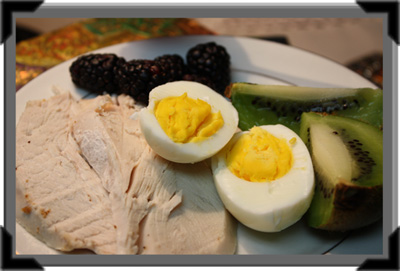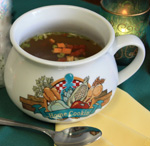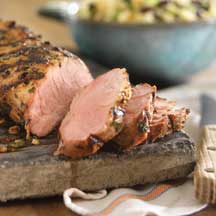Greetings!  After 19 years the USDA has this week updated food guidelines in a move that makes a lot of sense: a Food Plate. The flagship icon is a color-blocked dinner plate (shown at left) with sections to represent four food groups: fruits, vegetables, grains and protein, with a side serving of dairy. According to Kathleen Zelman, RD with WebMD, "We now have an easy-to-understand layout of what constitutes a healthy meal. Whether you are grocery shopping, packing lunches, or assembling a meal on a plate, the new food plan icon will serve as a constant reminder of the essential ingredients for a nutritious meal -- five easy pieces." These guidelines are written for the population in general and they are a great improvement over the ambiguity of the iconic 19-year-old pyramid. But for those of us managing our weight with bariatric surgery by following the high protein diet and Four Rules recommended by our surgeons the new simple diagram needs a few more details. I feel it is safe to say that all of us are invested in a healthier life when we undergo surgical weight loss and we know and learn (and re-learn) that a healthier way of life takes vigilance and lots and lots of hard work. The comprehensive "Choose My Plate" program that accompanies the new plate icon is a terrific addition to our health management toolbox. 
At LivingAfterWLS we have spent the hours since the full program was unveiled yesterday pouring over the program and looking for ways to include the recommendations of Choose My Plate into our bariatric weight loss program as well as into the nutritional management for our entire family. We are seeking manageable ways to make the plate icon above into the real-life dinner plate at right- something delicious and healthful and appropriate for our LivingAfterWLS menu. Today we are sharing what we have learned so far so that you may join us and jump in with both feet to embrace a new and improved way of nutrition management for ourselves and the entire family. You hear me say it often, that we are all in this together. And I think that means taking the best of what we learn from our regulatory governing agencies and applying it to our personal experience and knowledge. So here we go! Let me know what you think of the new food guidelines and how you plan to implement them at your table. Many of you share a goal with me -- to keep the next generation off the bariatric operating table. There has got to be a better way for the future and maybe we are onto it today! Share your story & tips: Send me an Email Throughout June we will be sharing information and making sense of the new dietary guidelines and resources available to us from the USDA. Just in case you missed it, we published Cooking with Kaye earlier this week to address the new cooking guidelines for Pork. This is important news for us since we can now cook pork that is moist and succulent and still be within appropriate temperature as recommended by the USDA. For your convenience we have included the feature article in this newsletter or Link Here for the full free newsletter available in our online archive. We have enjoyed hearing from so many of you already about how you love the recipes from this newsletter. Keep on cooking, Neighbors! CHEERS! Kaye Bailey Join me and others in the LivingAfterWLS Neighborhood - Your safe haven circle of friends.
We Support the American Red Cross Many in this country and around the world have been seriously impacted by natural disaster and weather related devastation in the recent weeks. At LivingAfterWLS we offer our thoughts and prayers for those affected that they may recover quickly and find a renewed sense of living and wellness in the wake of tragedy. We are supporting the efforts of the American Red Cross to help those affected. Please link below to go directly to the Red Cross website to learn about their relief efforts and how we can all do our part. American Red Cross Emergency Preparedness For Weight Loss Surgery Patients Emergency Preparedness For Weight Loss Surgery PatientsWeight loss surgery patients should take some extra steps in preparing an emergency readiness kit for use in the event of a natural or national disaster. Here are some good suggestions for preparing a special needs kit for the bariatric patient. Read article.
Feed the Carb Monster Soup Mixes LivingAfterWLS is pleased to present our own Feed the Carb Monster Soup Mixes. Avoid carb cravings with our delicious and nutritious soup mixes. When used with the 5 Day Pouch Test or your regular post-weight loss surgery diet these soups are effective at curbing carb cravings without the calories or guilt. Just .88 cents per serving! Two great flavors: Hearty Vegetable and Tomato-Basil. SHOP NOW |
| Advice We Like..... |
After reviewing the full content of the USDA's new "ChooseMyPlate" health recommendations we found a few nuggets of advice that we really like because they fit with our goals of weight and health management with weight loss surgery. Here we share some of the best nuggets we found and how they work for our unique dietary situation:
"Balance calories by enjoying food but eating less, and and by avoiding oversize portions." We have frowned on this sentiment before when our fellow WLS patients have said, "I can eat anything I want, just less of it, ha ha ha!" The implication of that old thinking was it didn't matter what we ate, only that we eat less and we will lose weight. Not quite true, many of you will agree! We know that to lose weight and to maintain weight loss we must follow a high-protein diet and avoid slider foods (empty calorie foods). But that doesn't mean we cannot enjoy our food. So let's reword this advice to say: "Enjoy carefully chosen nutritional and well prepared foods in a portion appropriate for our weight loss surgery pouch."
"Select a variety of protein foods to improve nutrient intake and health benefits, including at least 8 ounces of cooked seafood per week." We all know that Protein First is the first rule of the weight loss surgery diet. And most of us at some point have found ourselves bored sick of the same 'ole same 'ole protein. Honestly, how many ways are there to prepare boneless skinless chicken breasts? But the new guidelines offer a list of over 60 plant and animal proteins to include in our healthy diet. Check-out the list here: Protein Foods. You will find recipes and great ways to keep protein on your plate and never boring.

Including vegetables in our weight loss surgery is not only nutritional -it honestly helps tame carbohydrate cravings. Vegetables are complex carbohydrates. They deliver nutrients, minerals, and vitamins to our body and affect blood glucose levels naturally. They give us color and crunch and are willing participants in any preparation from raw and dipped to to oven roasted and seasoned with herbs and spices. Remember to follow the 2B/1B rhythm: 2 Bites Protein to 1 Bite Carbohydrate (including vegetable carbohydrate) to keep Protein First in your meal plan.
Here are some tips from the USDA for preparing vegetables and enjoying them as part of your healthy plate:
Buy fresh vegetables in season. They cost less and are likely to be at their peak flavor. Stock up on frozen vegetables for quick and easy cooking in the microwave. Buy vegetables that are easy to prepare. Pick up pre-washed bags of salad greens and add baby carrots or grape tomatoes for a salad in minutes. Buy packages of veggies such as baby carrots or celery sticks for quick snacks. Use a microwave to quickly "zap" vegetables. White or sweet potatoes can be baked quickly this way. Vary your veggie choices to keep meals interesting. LivingAfterWLS Veggie Recipes
|
Empty Calorie Foods:
We know them as Slider Foods
| 
The new USDA "My Plate" guidelines identify a food group that contributes to obesity and ill-health in this country and has until now been conspicuously ignored: Empty Calorie Foods. According to the USDA empty calorie foods contain solid fats and added sugars that have no nutritional value. Making the list of empty calorie foods are:
- Cakes, cookies, pastries, and donuts (contain both solid fat and added sugars)
- Sodas, energy drinks, sports drinks, and fruit drinks (contain added sugars)
- Cheese (contains solid fat)
- Pizza (contains solid fat)
- Ice Cream (contains both solid fat and added sugars)
- Sausages, hot dogs, bacon, and ribs (contain solid fat)
What is so critical for us with weight loss surgery to understand is that empty calorie food only takes up room in our pouch and provides the body caloric value that can easily be converted and stored as body fat. When we eat empty calorie foods and wash them down with liquids they become slider foods that literally slide right through the pouch into the remaining intestine where, because they are simple carbohydrates, they are absorbed by the body and stored as fat. We do this without the benefit of feeling a full pouch and in many cases weight gain results and addictive or compulsive eating behaviors are manifest.
We can avoid most empty calorie foods by following the bariatric Four Rules, specifically Rule #3: No Snacking. Some centers recommend small meals between meals and in this case the recommended eating list will include proteins -- not empty calorie foods. We know the foods that fall on this list and whether you call them empty calorie foods or snacks or slider foods we all know the ones that get us in trouble. Do the best you can on most days to avoid the foods that get us in trouble and enjoy the foods that make us strong and healthy. Just do your best. Refresher: Rule #3 No Snacking
|
LivingAfterWLS Resources
| Home Page - Blog - Kitchen - Library - Neighborhood
5 Day Pouch Test - 5 Day Pouch Test Blog
LivingAfterWLS General Store Publications - Seasonings - Soup Mixes - Fun Stuff

Turn up the Heat on the Grill!
Enter Coupon Code: GRILL2011 at checkout
Save $3 off any $20 order & get recipe & seasoning blend sample to make some crazy good barbecue sauce!
CODE: GRILL2011
Shop Now |
|
Great News for Pork Lovers:
The Puck Stops Here!
|  Previously published in our June 1, 2011 issue Cooking with Kaye Previously published in our June 1, 2011 issue Cooking with Kaye
| |
Promoted announcement from
Pork Be Inspired
For juicy, tender and flavorful pork, it might be time to toss out Grandma's advice. According to the new U.S. Department of Agriculture (USDA) guidelines, pork chops, roasts and tenderloins can be safely cooked to medium rare at a final internal cooked temperature of 145 degrees Fahrenheit as measured by a food thermometer, followed by a three-minute rest time.

The new cooking temperature will produce pork that's succulent and tender-not an over-cooked hockey puck - and will likely yield a finished product that is pinker in color than most of you are accustomed to.
Restaurants have been following this standard for nearly 10 years. The new temperature recommendation reflects advances in both food safety and nutritional content for today's pork, which is much leaner than Grandma's, and even Mom's, pork. On average, the most common cuts of pork have 27 percent less saturated fat than the same cuts 20 years ago.
Both the USDA and the National Pork Board recommend using a digital cooking thermometer to ensure an accurate final temperature. Ground pork, like all ground meat, should be cooked to 160 degrees Fahrenheit. Pre-cooked ham can be reheated to 140 degrees Fahrenheit, or enjoyed cold on sandwiches.
In addition to the new lower cooking temperature recommendation for pork, the USDA food preparation guidelines advise the following:
· Clean: Wash hands and surfaces often
· Separate: Don't cross-contaminate
· Cook: To proper cooking temperatures
· Chill: Refrigerate promptly
The National Pork Council has prepared a comprehensive easy to follow chart using the new USDA temperature guidelines. The download is free -- you don't even have to join their mailing list -- and I know you will find it to be a helpful resource in your kitchen.
Link: Be 145F Pork

Make a Note:
For owners of our LivingAfterWLS Publications please make a note of these new temperature guidelines while using the pork recipes. The following recipes should be updated to reflect the 145F cooking temperature:
Neighborhood Cookbook:
- Hawaiian Pork Skillet (page 119)
- Lemon Pork Chops (page 123)
- Pork Au Poivre with Mustard Sauce (page 131)
5 Day Pouch Test Owner's Manual:
- Low-carb Pumpkin & Sausage Soup (page 69)
- Spinach-Sausage Egg Bake (page 75)
Day 6: Beyond the 5 Day Pouch Test
- Basic Food Handling (page 213)
- Calypso Pork Chops (page 185)
- Italian Pork Skillet with Eggplant & Squash (page 184)
- Southwestern Grilled Pork Tenderloin (page 186)
Get these books: 
We are pleased to offer exclusively books published by LivingAfterWLS, LLC with the intent of enhancing the lives of those who courageously chose to battle obesity with a surgical weight loss option. Bookworm Bundle - Save 20% Shown Above: Build your LivingAfterWLS Library with our Best Selling Books and save 20% with a Bundle Purchase! Bookworm Bundle includes: 5 Day Pouch Test Owner's Manual by Kaye Bailey -- List: $24.95
Day 6: Beyond the 5 Day Pouch Test by Kaye Bailey -- List: 29.95
The Neighborhood Cookbook edited by Kaye Bailey -- List: $20.00
500 Pages of Information, Inspiration, Motivation, Recipes to support your long-term success with weight loss surgery. |
$74.95 Value --- for $59.95 SAVE 20%
Use Coupon Code GRILL2011 & Save $3.00 More!
Free Goody Bag with Bundle!
BUY NOW!
|
|
I wish you the best health and happiness LivingAfterWLS!
Cheers!
Kaye Bailey
LivingAfterWLS, LLC
|
|
|
|
|
|
| "The centerpiece of the program is this next-generation food icon. The icon is the visual cue to get to online resources, to online media, and to unified nutrition messages from public- and private-sector efforts."
--Robert C. Post, PhD
Deputy Director of USDA
ChooseMyPlate.gov |
| USDA Ditches Food Pyramid for a Healthy Plate |  |
From WebMD
By Daniel J. DeNoon
WebMD Health News
Reviewed by Laura J. Martin, MD
June 2, 2011 -- A colorful four-part plate, with a side dish of dairy, has replaced the 19-year-old food pyramid as the icon of the new U.S. Dietary Guidelines. The new icon, called "My Plate," is split into four sections -- red for fruits, green for vegetables, orange for grains, and purple for protein -- with a separate blue section for dairy on the side. Agriculture Secretary Tom Vilsack unveiled the icon at a news conference today. He said the food pyramid was "simply too complex to serve as a quick and easy guide for American families." At the news conference, first lady Michelle Obama praised My Plate as "a wonderful, kid-friendly tool" that's practical for busy families. "What's more simple than a plate?" she asked. "I'm confident that families will find this useful. They can start using this today." The Obamas are already doing so. "Trust me: We are implementing this in our household," Obama said. The icon represents more than the currently recommended diet. It's part of a drastic change. The old plan was to provide information. The new plan is to actively change American eating behavior, using all the tools of modern persuasion. "The centerpiece of the program is this next-generation food icon," Robert C. Post, PhD, deputy director of the U.S. Department of Agriculture (USDA) center for nutrition policy and promotion, tells WebMD. "The icon is the visual cue to get to online resources, to online media, and to unified nutrition messages from public- and private-sector efforts." Expect a barrage of messages and reminders from the food industry, nutrition gurus, chefs, schools, nonprofit agencies, and every government agency with anything at all to say about nutrition or health. Twitter feeds, Facebook pages, and blogs will trumpet the healthy diet program. Eating is only half the picture. Michelle Obama's Let's Move program will take the lead in motivating Americans to get more exercise. (Get a printable image of the new food icon with options for your meals.)
|
| LivingAfterWLS General Store
Celebrate Grilling Season!
Coupon Code: GRILL2011
Save $3 & Get Free Recipe with Seasoning Sample to make
Delicious Barbecue Sauce!
Total Value: $3.95!!
Minimum purchase $20
May 30-June 30
Enter code at checkout:
GRILL2011
|
| |
Shop Now
|
got your dairy today?
| Dairy Group
| |
All fluid milk products and many foods made from milk are considered part of this food group. Most Dairy Group choices should be fat-free or low-fat. Foods made from milk that retain their calcium content are part of the group. Foods made from milk that have little to no calcium, such as cream cheese, cream, and butter, are not. Calcium-fortified soymilk (soy beverage) is also part of the Dairy Group.
Consuming dairy products provides health benefits - especially improved bone health. Foods in the Dairy Group provide nutrients that are vital for health and maintenance of your body. These nutrients include calcium, potassium, vitamin D, and protein.
Intake of dairy products is linked to improved bone health, and may reduce the risk of osteoporosis.
The intake of dairy products is especially important to bone health during childhood and adolescence, when bone mass is being built.
Intake of dairy products is also associated with a reduced risk of cardiovascular disease and type 2 diabetes, and with lower blood pressure in adults.
Calcium is used for building bones and teeth and in maintaining bone mass. Dairy products are the primary source of calcium in American diets. Diets that provide 3 cups or the equivalent of dairy products per day can improve bone mass.
Why is it important to make fat-free or low-fat choices from the Dairy Group? Choosing foods from the Dairy Group that are high in saturated fats and cholesterol can have health implications. Diets high in saturated fats raise "bad" cholesterol levels in the blood. The "bad" cholesterol is called LDL (low-density lipoprotein) cholesterol. High LDL cholesterol, in turn, increases the risk for coronary heart disease. Many cheeses, whole milk, and products made from them are high in saturated fat. To help keep blood cholesterol levels healthy, limit the amount of these foods you eat. In addition, a high intake of fats makes it difficult to avoid consuming more calories than are needed. |
| Social Connections |  | |
We are all in this together!
Let's connect!




|
LivingAfterWLS
Bulletin Board
|
|
Now in the Fourth Printing!  A Collection of Neighborhood Recipes A Collection of Neighborhood RecipesAfter a brief interruption we now have the popular LivingAfterWLS Neighborhood Cookbook back in stock! Fourth printing. Over 10,000 copies in circulation! Enjoy! SKU# 1241715152 List Price: $20.00 Sale Price: $18.00 
Shop More Books
|
|  | |
Please enjoy these previously published LivingAfterWLS Newsletters:
Cooking with Kaye
Pork: New Cooking Guidelines
Lower the Temp-Raise the Enjoyment!
June 1, 2011
Late last month (May 2011) the United States Department of Agriculture announced new cooking guidelines for pork and this is GREAT news for weight loss surgery patients. In today's cooking with Kaye we have filled the page with great recipes starring pork that are high in protein and flavor. Give these recipes a try and I think you will enjoy pork more than ever before.
5 Day Pouch Test Bulletin
March 27, 2011 Liquid Restrictions: More than just rules Learn Why they matter & How to work them into your day!
LivingAfterWLS Digest
March 28, 2011 Spring Renewal: It's Your Time to Bloom "Review health and WLS status and wellness; plan healthy habits for coming days and weeks." Wouldn't it be nice if we received a gentle reminder in the mail to spring clean our weight loss surgery house? Here it is.
Cooking with Kaye
February 12, 2011 Happy Valentines Day! Smart, Delicious WLS-Safe Chocolate Indulgence Excellent Splurge Recipes
5 Day Pouch Test Bulletin
January 17, 2011 Top Questions & Answers from 2010 Improving your 5 Day Pouch Test experience in 2011
Cooking with Kaye
January 13, 2011 All in the Family Healthy-Fun-WLS Family Friendly Meals! Wiggly-Jiggly Gelatin Side Dishes Everyone will Love!
|
|
|